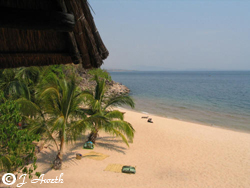This vast inland sea was first made known to the European world in the mid 1800’s by the English explorers Richard Burton and John Speke. They pursued it as the source of the Nile, arriving at its shores in February of 1858, only to discover that the Ruzizi River in the north, which they thought to be the Nile, flowed into and not out of the lake. (Their incredible journey is documented in the movie ‘Mountains of the Moon’.)
| Tanganyika's waters lap Tanzania, Burundi, Congo DR and Zambia. It is the longest fresh water lake in the world and the second deepest after lake Baikal in Russia. The immense depth is because it lies in the Great Rift Valley, which also has created its steep shoreline. It reaches a depth of 1433 metres (4 700 feet), which is an astounding 642m below sea level.Although Zambia can only lay claim to 7% of its surface area, it stretches north to south a distance of 677 kilometres (420 miles) and averages about fifty kilometers wide (31 miles). The clear waters host more than 350 different species of fish and is well known for aquarium fish exports and excellent angling. |
 |
The fertile circulating surface water, although not tidal, provides abundant plankton for its inhabitants which in turn provides much needed protein for both the local and export markets. The stiff winds that blow off the surrounding mountains aid the continual movement which inhibits the spread of bilharzia, the parasitic disease carried by shallow water snails.
A pair of fish eagles guards the gentle bay, their distinctive black, white and chestnut feather pattern gleaming boldly in the morning sun. Suddenly, the birds toss back their heads in a piercing, evocative duet. On the sandbank below, a well-fed monster of a crocodile snaps to life, startled from its nap. It stampedes through the crunchy undergrowth, crashing into the water in front of the boat, invisible except for a pair of sentry-post eyes that peek menacingly above the surface to monitor our movements. |
